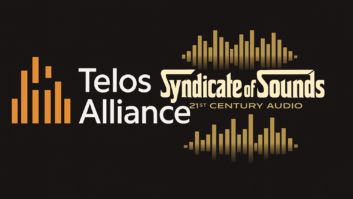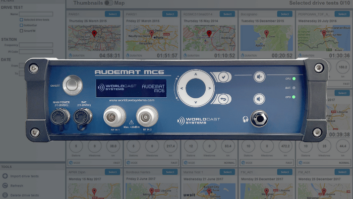WASHINGTON�The National Association of Broadcasters has offered several proposals about AM revitalization on issues as diverse as siting cross-service FM translators and relaxing main studio rules.
�
Most pressingly, the NAB said it sees no reason for the Federal Communication Commission to set a special limit on cross-service translators in its effort to revitalize the U.S. AM radio band.
�
�The �core market area� for many AM stations continues to grow and shift,� the NAB wrote in its filing. �It is critical that AM stations have the flexibility to follow and serve these listeners.�
�
The commission should revise the standards for locating FM cross-service translators, saying that a new 40-mile cap being proposed may unnecessarily hinder their use by some AMs. Existing rules require that the 60 dB� contour of an FM cross-service translator must be contained within the smaller of the 25-mile radius from the AM station�s transmitter site or the AM station�s daytime 2 mV/m contour. The NAB said these criteria are too restrictive in certain situations, such as where a station�s transmitter site is located far from a population center because of land costs.

�
�For example, the rule can make it difficult for stations to cover a core service area that is located beyond the 25-mile radius but within the 2 mV/m contour, preventing stations from using an FM translator where it is needed the most,� the association wrote. It also said the rule also does not take into account the directionality of numerous AM stations and the possibility that a null in the directional pattern of an AM station may exclude otherwise suitable translator locations.
�
In a previous comment, the NAB recommended that instead of limiting a translator�s 60 dB� contour to the smaller of an AM station�s 25-mile radius � with an emphasis on �smaller� � or daytime 2 mV/m contour, the translator should be able to cover the �greater� of these benchmarks, to increase the flexibility of AM stations in locating FM translators. The FCC agreed to this recommendation in its Further Notice of Proposed Rulemaking on AM revitalization, but proposed a new restriction that the translator�s coverage contour may not extend beyond a 40-mile (64 km) radius centered at the AM station�s transmitter site. The commission said this will provide useful signal coverage without extending an AM radio station�s coverage beyond its �core service area.�
�
But the existing 2 mV/m contour cap effectively ensures this, the NAB said.
�
�The newly proposed 40-mile cap should be eliminated as unnecessary because the existing 2 mV/m contour cap effectively constrains operation to the station�s core service area,� the NAB said. The broadcast association also questioned whether the new limit will raise similar concerns as the previous standard, since a 40-mile maximum distance is no less arbitrary than the 25-mile limit. �It will still disadvantage AM stations seeking to reach listeners in a core area located 41 miles or more away from the station�s transmitter site, but within the station�s 2 mV/m contour,� the NAB said.�
�
NAB also pressed the FCC to consider its proposal of reducing the daytime protected contour for Class B, C and D stations from the 0.5 to the 2 mV/m contour to allow AM stations to increase power and signal strength to overcome increased levels of environmental noise.
�
But modifying daytime protections for these stations is a complicated approach that may benefit some stations, hurt others and produce unintentional consequences. An NAB-commissioned study examined the potential changes in population and geographic coverage of 14 AM �root� stations, as well as the impact on nearby �affected� stations. The study found that when a root station increases signal power, this higher power increases the population within the root station�s 2 mV/m contour and impacts the ability of nearby affected AM stations to do a subsequent power increase.
�
While the study�s results cannot be considered representative of the impact throughout the AM band, the NAB said, �the primary conclusions to be drawn from the study are that when a station increases its power under the proposed changes, it is likely to expand its interference-free population � but in doing so the interference-free population of nearby stations can be harmed.�
�
The most important step the commission can take to improve AM radio reception �is to control and reduce the ever-increasing noise floor that degrades AM signal quality,� the NAB said, asking the commission to more deeply review Part 15 rules and to take steps to clarify that all such devices fall under the commission�s purview.�
�
�The commission should undertake a two-pronged approach of allowing AM stations to increase power to overcome environmental noise � without harming or hindering other stations � while modernizing and vigorously enforcing its Part 15 rules and other policies intended to constrain undesired RF radiation,� the NAB said in its filing.�
�
The NAB supports relaxing the main studio requirements, saying this would allow stations to redirect resources toward programming and public service. As it stands, a station�s main studio must be located either within a station�s principal community contour, within the contour of any other broadcast station licensed to its community, or within 25 miles of the center of its community.
�
Benefits include eliminating personnel, facilities and equipment costs, and promoting collaboration among station staff. �Today, advances in technology have virtually eliminated the need for a local main studio, as almost all audience contact with broadcasters is by email or telephone,� the NAB said in its filing. The Multicultural Media, Telecom and Internet Council this week also called on the FCC to eliminate the main studio rule entirely, calling it a relic.
�
The NAB also requested that the commission relax staffing requirements, which currently require a broadcaster to maintain a full-time management and full-time staff presence at their main studio.
�
Read the NAB�s full comments,including a summary of the study commissioned by the association.
�
A version of this article was originally posted on the website of Radio World, sister publication of Radio magazine.�
�







